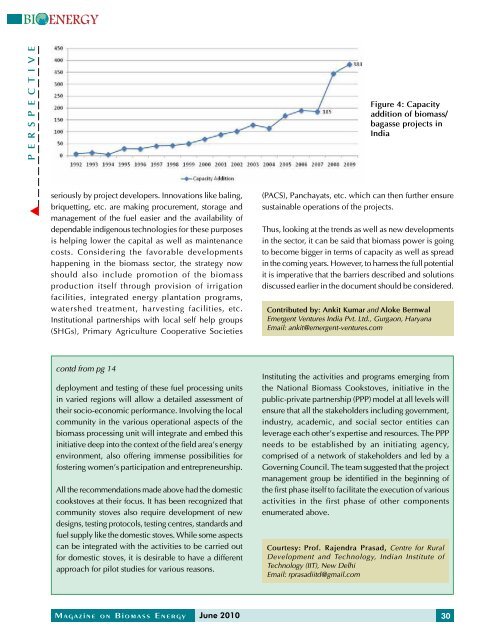issue 4 - United Nations Development Programme
issue 4 - United Nations Development Programme
issue 4 - United Nations Development Programme
You also want an ePaper? Increase the reach of your titles
YUMPU automatically turns print PDFs into web optimized ePapers that Google loves.
P E R S P E C T I V E<br />
Figure 4: Capacity<br />
addition of biomass/<br />
bagasse projects in<br />
India<br />
seriously by project developers. Innovations like baling,<br />
briquetting, etc. are making procurement, storage and<br />
management of the fuel easier and the availability of<br />
dependable indigenous technologies for these purposes<br />
is helping lower the capital as well as maintenance<br />
costs. Considering the favorable developments<br />
happening in the biomass sector, the strategy now<br />
should also include promotion of the biomass<br />
production itself through provision of irrigation<br />
facilities, integrated energy plantation programs,<br />
watershed treatment, harvesting facilities, etc.<br />
Institutional partnerships with local self help groups<br />
(SHGs), Primary Agriculture Cooperative Societies<br />
(PACS), Panchayats, etc. which can then further ensure<br />
sustainable operations of the projects.<br />
Thus, looking at the trends as well as new developments<br />
in the sector, it can be said that biomass power is going<br />
to become bigger in terms of capacity as well as spread<br />
in the coming years. However, to harness the full potential<br />
it is imperative that the barriers described and solutions<br />
discussed earlier in the document should be considered.<br />
Contributed by: Ankit Kumar and Aloke Bernwal<br />
Emergent Ventures India Pvt. Ltd., Gurgaon, Haryana<br />
Email: ankit@emergent-ventures.com<br />
contd from pg 14<br />
deployment and testing of these fuel processing units<br />
in varied regions will allow a detailed assessment of<br />
their socio-economic performance. Involving the local<br />
community in the various operational aspects of the<br />
biomass processing unit will integrate and embed this<br />
initiative deep into the context of the field area’s energy<br />
environment, also offering immense possibilities for<br />
fostering women’s participation and entrepreneurship.<br />
All the recommendations made above had the domestic<br />
cookstoves at their focus. It has been recognized that<br />
community stoves also require development of new<br />
designs, testing protocols, testing centres, standards and<br />
fuel supply like the domestic stoves. While some aspects<br />
can be integrated with the activities to be carried out<br />
for domestic stoves, it is desirable to have a different<br />
approach for pilot studies for various reasons.<br />
Instituting the activities and programs emerging from<br />
the National Biomass Cookstoves, initiative in the<br />
public-private partnership (PPP) model at all levels will<br />
ensure that all the stakeholders including government,<br />
industry, academic, and social sector entities can<br />
leverage each other’s expertise and resources. The PPP<br />
needs to be established by an initiating agency,<br />
comprised of a network of stakeholders and led by a<br />
Governing Council. The team suggested that the project<br />
management group be identified in the beginning of<br />
the first phase itself to facilitate the execution of various<br />
activities in the first phase of other components<br />
enumerated above.<br />
Courtesy: Prof. Rajendra Prasad, Centre for Rural<br />
<strong>Development</strong> and Technology, Indian Institute of<br />
Technology (IIT), New Delhi<br />
Email: rprasadiitd@gmail.com<br />
Magazine on Biomass Energy June 2010 30
















